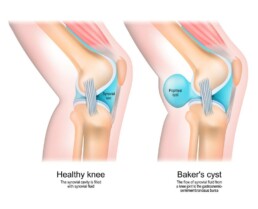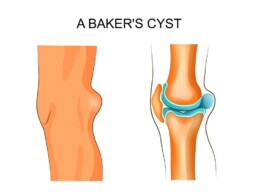What is a Baker’s cyst?
A Baker’s cyst is a fluid-filled sac that develops on the back of the knee due to an excess of the synovial fluid that lubricates the interior of the knee. This type of cyst is named after William Morrant Baker, the 19th-century physician who was the first to describe the condition. It is also called a popliteal cyst, referring to the area behind the knee.
Synovial fluid not only lubricates all the body’s joints; it reduces friction there. A tear in the knee’s cartilage or inflammation from arthritis can result in an overproduction of the fluid. The build-up of this excess fluid becomes a Baker’s cyst. It may also be caused by poor leg biomechanics.

A small Baker’s cyst may not produce symptoms, but a larger cyst may be accompanied by pain and swelling and can restrict the degree to which the knee can bend. The symptoms vary, but they can include:
- Stiffness or tightness in the back of the knee, thigh, or upper calf.
- Pain behind the knee, particularly with full flexion (bending) or extension (straightening). You may also experience pain in the upper calf or back of the thigh.
- Pain when sitting when the chair touches or rubs the area behind the knee.
- Swelling and redness behind the knee. If the cyst ruptures, then the swelling may be also be in the lower leg and calf area. It usually worsens when standing.
- Fatigue and restless leg at night.
Diagnosis
A Baker’s cyst may be located below the skin, so it may not be visible to the eye. In diagnosing it, your physician should employ range of motion testing, palpation and observation of swelling patterns. They should also ask you about your medical history to determine whether you have had any recent knee trauma or suffer from any arthritic conditions. An MRI or ultrasound may be required, especially because the symptoms are similar to those of other knee problems.
Often, a Baker’s cyst will resolve on its own over time, given rest and treatment of symptoms. However, your physician may prescribe a course of anti-inflammatory medication (orally), a cortisone injection, aspiration of the fluid by utilizing a needle, and/or surgical removal.
Physiotherapy can assist you in regaining your mobility and maintaining your fitness so that the cyst doesn’t recur. A registered physiotherapist may use acupuncture or dry needling to aid your healing and will work with you to restore your range of motion and strengthen the quadriceps and hip abductor muscles, areas where weakness often contributes to poor biomechanics.

Treatment: Is It Good to Wrap a Baker’s Cyst?
Initially, if you suspect a Baker’s cyst, you can follow the RICE protocol: rest, ice, compression and elevation. Remember, rest may prompt the cyst to heal on its own. When you ice the cyst, never put the ice directly onto bare skin; wrap it in a towel for protection or use a bag of frozen peas. Ice your cyst for no more than 20 minutes each hour.
You may want to wrap the knee, since compression is known to decrease swelling. Before you consult with your doctor or physiotherapist, you can use an ACE bandage or a pair of thigh-high (NOT knee-high) compression socks.
What Makes the Best Knee Wrap for Baker’s Cyst?
Once you are certain you have a Baker’s cyst, ongoing compression may help you heal. The best knee wrap for your cyst combines compression, ice and stability. Compression is an excellent method of lessening the swelling and allowing the fluid to reabsorb. Ice is a great way to reduce the pain caused by the cyst and can prevent the need for medication. Stability is important if the cyst was caused by damage to the joint or degenerative changes.
Here are three types of knee wraps that are worth considering:
- Knee Compression Sleeve. An elastic bandage is easy to slide on and off and is comfortable for you to wear. It helps reduce swelling.
- Knee Brace with Ice Pack Wrap. A compression knee brace with Velcro closures that also has space to insert ice that cools the back of the knee – two keys to relieving pain and reducing swelling.
- Decompression Knee Brace. If your knee is unstable, especially if there have been degenerative changes to the joint, consider a hinged brace that provides both compression and lateral stability.
Remember: while you are suffering from a Baker’s cyst, listen to your physiotherapist’s advice regarding exercise, and IF IT HURTS, DON’T DO IT!
